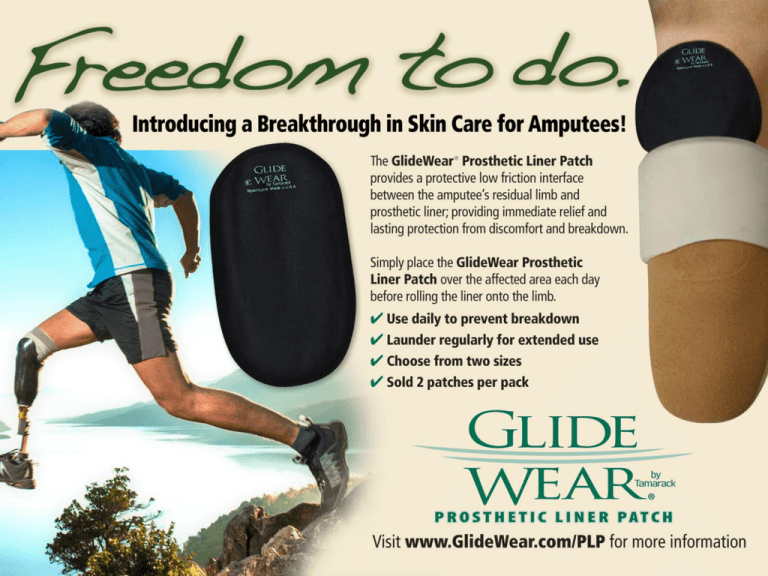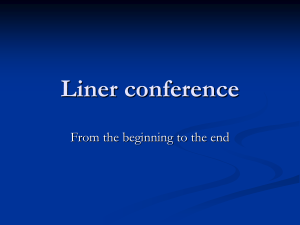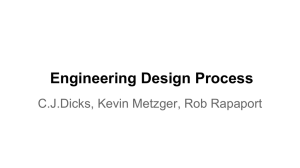
GlideWear® Prosthetic Liner Patch
Presentation of a New
Intervention for the Management
of Skin Breakdown for Amputees
Presenter Intro + Disclosures
Charles W. Kuffel MSM, CPO, FAAOP is the
President & Clinical Director at Arise Orthotics &
Prosthetics.
Kevin Hines CPO is an owner & certified
prosthetist-orthotist at Arise Orthotics &
Prosthetics.
Presenter Intro + Disclosures
Charles & Kevin both serve as clinical consultants
for Tamarack Habilitation Technologies.
Jason Pawelsky is the Sales & Marketing
Manager at Tamarack Habilitation Technologies
with 8 years of O&P product developmentrelated sales & marketing experience.
Webinar Agenda
• Discuss the skin care challenge faced by
Prosthetists and Amputees
• Introduce friction management concept and
its role in wound care
• Introduce GlideWear Prosthetic Liner Patch
• Present case studies
• Q&A
• Contact Information
The Prosthetist’s Dilemma
• Approx. 1.9 million amputees in the U.S.
• Over 65k LL amputations annually due to
diabetes alone
• Annual prosthetic liner utilization estimated
at over 200k units
• Skin integrity disruption is a constant struggle
for the Prosthetist and rising amputee
population – it is not isolated by diagnosis,
geography, liner, or device type
Interface Design Concerns
A recent survey of Prosthetists about the design of
prostheses conducted on the OandP-L (n = 95) revealed:
• Nearly 50% concluded that the most
important area for prosthetic device design
improvement is on interface materials
• The distal tibia and fibular head ranked as
most common areas of socket discomfort for
transtibial amputees.
Got Pressure?
Pressure reduction in at-risk areas is an essential
component of skin tissue health and is the
leading focus amongst clinicians.
However, pressure isn’t the only consideration…
Once a prosthetic socket is fabricated, both
friction and moisture must also be
appropriately managed.
The Impact of Friction &
Shear on Human Soft Tissue
Intrinsic
Factors
General health, nutrition, age, neuro-muscular and
neuro-sensory status, metabolic status, etc.
Global
Factors
Patient education, motivation, lifestyle, program
follow-up, etc.
Extrinsic
factors
Pressure
Friction & Shear
Microclimate
Extrinsic Factors - Summing It Up:
1.
P
FF
Fs
2.
3.
4.
By addressing the extrinsic factors, 4 results will have to be met:
1.
2.
3.
4.
Improvement of microclimate
Redistribution of pressure loads
Management of static and dynamic friction
Minimization of shear forces in at-risk areas
Repetitive Loading
• During ambulation, load is applied to the skin,
reaches a maximum and, in the unloading
phase, incurs tensile stress caused by the
weight of the prosthesis. This series of loading
cycles occurs again, and again, and again…
• Virtually all repetitive loading has a “rub”
(friction) component.
• When insufficiently addressed, skin
breakdown occurs.
Repetitive Loading
Every ambulatory person has experience with this…
– It is an occasional irritant for “Mr. Blue”
– It causes significant discomfort and occasional
breakdown for “Ms. Green”
– “Mr. Red” is unable to wear his leg until his wound
heals – keeping him from living the active lifestyle
he enjoys with his family & friends
Let’s examine what this looks
like clinically…
Tissue Trauma Examples
Conventional “Wisdom”
Red skin = “Pressure Area”
So, must reduce peak pressure… End of story.
BUT REMEMBER!
Reducing pressure decreases the clinical
control that was originally desired
Lost opportunity to enhance and extend
function
Labor intensive (costly)
How do we currently
address friction and shear?
Skin lubricants – lotions & gels
Messy to apply
Likely to spread beyond targeted area
Hydrates skin when absorbed, increasing the
coefficient of friction between skin and liner –
making skin more susceptible to trauma
Short term solution – needs frequent reapplication.
Contraindicated for some liners
How do we currently
address friction and shear?
Moisture Management Liners
Only addresses 1/3 of the equation
Not widely used amongst amputees
Skin-Drying Powders
Messy to apply
Limited duration of protection
The Friction Factor
By introducing a low friction material at the
interface of the device and skin, friction is
virtually eliminated in targeted, at-risk areas.
It’s important to mention that friction is
important when it comes to supporting proper
device fit & function– just not when it causes
shearing and skin trauma.
What is GlideWear?
Patented dual-ply low friction fabric technology
Manufactured in Minneapolis, Minnesota by
Tamarack Habilitation Technologies
First commercialized in 2009 for use in wheelchair
cushion covers and in 2013 for prosthetic liners
GlideWear is a comfortable, versatile, long-lasting and
highly effective shear management technology.
GlideWear® Prosthetic Liner Patch
Indications for Use
Indicated for nearly every amputee who experiences
discomfort and skin breakdown from their prosthetic liner
or socket.
Critical Sites of Skin Breakdown include…
Patella
Popliteal
Distal anterior tibia
Fibular head
Also recommended as a tool to prevent
premature liner breakdown!
GlideWear® Prosthetic Liner Patch
Features
Easy to Use
Available in two sizes. Place appropriately-sized GlideWear Patch
against the targeted area before rolling the liner over the top.*
Provides Targeted Shear Reduction
Shearing occurs between the dual ply GlideWear fabric; not against
the skin in at-risk areas.
Extremely Durable
Reuse daily and launder frequently for months of worry-free skin protection
Tested through 100 wash/dry cycles and 180,000 rub cycles to ensure
durability through long term use.
*Do not apply directly over open wounds.
GlideWear® Prosthetic Liner Patch
Benefits
For Amputees
For Practitioners
Immediate improvement in
comfort
Less extensive socket
recontouring = better fit and
function
Better wound-healing
environment
Eliminates need for messy and
ineffectual cream & powder use
Reduction of “early returns” due
to nagging skin problems
Reduced practitioner time on
non-billable facility expense
Protect liners from early wear-out
No reimbursement battles!
Enjoy months of daily use with a
single patch -> cost-effective!
GlideWear® Prosthetic Liner Patch
User Instructions
1) Position the GlideWear Prosthetic
Liner Patch over the affected area.
1) Roll the liner over the GlideWear
Patch to complete placement process.
1) Use clean, dry patch daily to ensure lasting
protection. Launder as needed.
GlideWear® Prosthetic Liner Patch
Purchasing Options
Choose from 2 size options:
Small (2.5 in. x 4.75 in.)
Suitable size for most users!
USD $27 MSRP
Large (4.5 in. x 7.5 in.)
For larger limbs & coverage needs
USD $34 MSRP
Sold 2 patches (same size) per pack
GlideWear Tips
GlideWear is not intended for placement directly against open
wounds.
Always follow standard wound cleaning & coverage
procedures (as recommended by a licensed healthcare
professional) to support a healthy wound-healing
environment.
To avoid recurrence of skin breakdown after healing,
amputees should continue using the GlideWear Prosthetic
Liner Patch daily to protect against future issues in at-risk
areas.
Conclusions
• Skin breakdown in the amputee population
can be addressed in numerous ways.
• Pressure, shear, and microclimate must all be
managed to optimize device fit, comfort, and
skin protection.
• GlideWear offers a simple, low-cost, and longlasting solution for shear-related discomfort
and breakdown for amputees.
Q&A + Contact Info
GlideWear Prosthetic Liner Patch
Questions/Comments?
Please contact:
To Order GlideWear Prosthetic
Liner Patches, or receive
Product Support please contact:
Jason Pawelsky
Becker Orthopedic
Sales & Marketing Manager
Customer Service
JasonP@tamarackhti.com mail@beckerorthopedic.net
(866) 795-0057 toll-free
(800) 521-2192 toll-free
(763) 795-0057 local
(800) 923-2537 fax
www.glidewear.com/PLP
BeckerOrthopedic.com
© 2014 Tamarack Habilitation Technologies, Inc. All Rights Reserved
CEU CREDITS
• To obtain CEU Credits, please refer back to the
listing for this presentation on the Becker
website and click the Test Questions link.
• After completing the Test Questions Form,
please print the document for your records.
You can then scan the document and upload it
to us by selecting the Clinical/Technical
Support button on the Becker website, or fax
it to us at (800) 923-2537.








